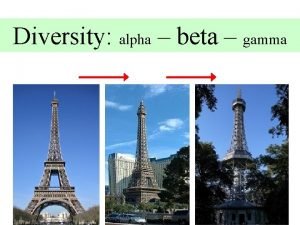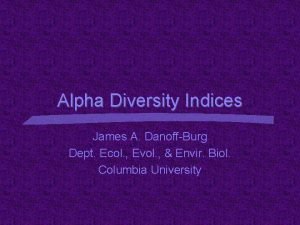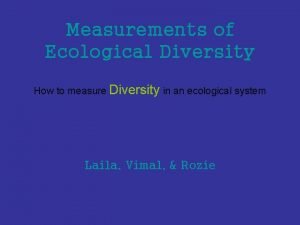Alpha diversity In ecology alpha diversity diversity is
























- Slides: 24

Alpha diversity In ecology, alpha diversity (α-diversity) is the mean species diversity in sites or habitats at a local scale

Alpha diversity • Alpha diversity (α-diversity) is expressed in terms species richness or number of species in an ecosystem. • The alpha diversity can be measured by counting the distinct group of organisms such as different species, genera, and families or number of taxonomic units (number of taxa) within the ecosystem.

Beta diversity • Beta diversity (β-diversity) is defined as the quantitative measurement of diversity of communities along environmental gradients.

Gamma diversity • Gamma diversity (γ-diversity) is defined as the species richness or total number of species over a large region (ecological, units) • Gamma diversity also called as large-scale landscape diversity

Types • True beta diversity • Gamma diversity and alpha diversity can be calculated directly from species inventory data. • The simplest of Whittaker's original definitions of beta diversity is • β = γ/α • Here gamma diversity is the total species diversity of a landscape and alpha diversity is the mean species diversity per habitat.

Absolute species turnover • Some researchers have preferred to partition gamma diversity into additive rather than multiplicative components. • Then the beta component of diversity becomes • βA = γ - α • This can also be interpreted as the total amount of species turnover among the subunits in the dataset.

Whittaker's species turnover • If absolute species turnover is divided by alpha diversity, a measure is obtained that quantifies how many times the species composition changes completely among the subunits of the dataset. • This measure was proposed by Whittaker, so it has been called Whittaker's species turnover. It is calculated as • βW = (γ - α)/α

Proportional species turnover • If absolute species turnover is divided by gamma diversity, a measure is obtained that quantifies what proportion of the species diversity in the dataset is not contained in an average subunit • It is calculated as βP = (γ - α)/γ

Functional diversity can refer to: the elements of biodiversity that influence how ecosystems function

Functional diversity through history • Models social treatment of functionally diverse people can be found through history • These models coexist nowadays with different levels of intensity

Cut out approach • A first model or approach could be named as the cut out approach. In this model, functional diversity is based on religious grounds and these different people are considered unnecessary due to different reasons: They do not contribute to community needs, 1. Because they are evil messages carriers, 2. Because they the result of gods anger or 3. Because they are disgraced and their life is not worth living.

Conti… • As a consequence, society gets rid of functionally diverse people cutting them out of society • or • By placing them in specific sites designed for abnormal and poor people

Rehabilitation model • Under this conception, the origin and causes of functional diversity are not religious, but scientific. • Functionally diverse people are not considered useless or unnecessary, as long as they are rehabilitated. • In this model or approach the main goal is to normalize men and women who are different, even if it implies hiding the functional diversity’s difference.

Systematic diversity • The study of the diversification of living forms, both past and present, and the relationships among living things through time. Relationships are visualized as evolutionary trees

Diversity indices • Over 60 indices used in ecology • Indices used to measure proportional abundance • Two major forms: – Dominance indices (e. g. Simpson index) – Information indices (e. g. Shannon Weiner index)

Simpson Diversity Index (D) • A community dominated by one or two species is considered to be less diverse than one in which several different species have a similar abundance. • Simpson's Diversity Index is a measure of diversity which takes into account the number of species present, as well as the relative abundance of each species. As species richness and evenness increase, so diversity increases.

Simpson Diversity Index (D) – Simpson’s index considered a dominance index because it weights towards the abundance of the most common species. – measures the chances two individuals randomly selected from a sample will belong to the same category – For example, the chances of two trees, picked at random from a tropical rainforest being of the same species would be relatively low , whereas in the boreal forest would be relatively high

• n = the total number of organisms of a particular species • N = the total number of organisms of all species • The value of D ranges between 0 and 1. • With this index, 1 represents infinite diversity and 0, no diversity.

Conti… Species Acacia modesta Acacia nilotica Albizia lebbeck Aconitum heterophyllum Dalbergia scisso Total Number (n) 2 8 1 n(n-1) 2 56 0 1 0 3 6 15 64 N = 15 £ n(n-1) = 64

Putting the figures into the formula for Simpson's Index: Simpson's Index of Diversity = 0. 7

Simpson Diversity Index (D) Sugar Red Yellow Maple Birch # Trees 56 48 12 Red Oak White Ash Total 6 3 125

Shannon-Weiner Index (H') • Assumptions: – All species represented – Sample randomized (equal chance of being selected in the sample) H' = - pilnpi pi= proportion of the ith species ln=natural logarithm

Where • pi = No of individuals of species/ Total number of species • Hmax=ln(S) = Maximum diversity possible • SS = number of species, or species richness • EE = Evenness = H/hmax Problem Statement: The samples of 5 species are 60, 10, 25, 1, 4. Calculate the Shannon diversity index and Evenness for these sample values. Sample Values (S) = 60, 10, 25, 1, 4 number of species (N) = 5 First, let us calculate the sum of the given values. sum = (60+10+25+1+4) = 100

Species (i)(i) No. in sample pi ln(pi) pi×ln(pi) Big bluestem 60 0. 60 -0. 51 -0. 31 Partridge pea 10 0. 10 -2. 30 -0. 23 Sumac 25 0. 25 -1. 39 -0. 35 Sedge 1 0. 01 -4. 61 -0. 05 Lespedeza 4 0. 04 -3. 22 -0. 13 S=5 Sum = 100 H=1. 07 Hmax=ln(S)=ln(5)=1. 61 E=1. 07/1. 61=0. 66 Shannon diversity index(H)=1. 07 Evenness=0. 66 Sum = -1. 07
 Biological diversity meaning
Biological diversity meaning Aka graduate information session
Aka graduate information session Arcom mission statement
Arcom mission statement Npte pharmacology
Npte pharmacology Alpha kappa alpha strategic plan
Alpha kappa alpha strategic plan Alpha kappa alpha slides
Alpha kappa alpha slides Alpha kappa alpha membership intake process manual
Alpha kappa alpha membership intake process manual Alpha phi alpha
Alpha phi alpha Phi alpha delta binghamton
Phi alpha delta binghamton Alpha kappa alpha hymn and pledge
Alpha kappa alpha hymn and pledge Zeta phi beta chart of fees
Zeta phi beta chart of fees Alpha beta and gamma diversity
Alpha beta and gamma diversity Alpha diversity index
Alpha diversity index Alpha beta gamma diversity
Alpha beta gamma diversity Ecosystem jigsaw activity
Ecosystem jigsaw activity Why is genetic diversity important
Why is genetic diversity important Yale industrial ecology
Yale industrial ecology Chapter 55 ecosystems and restoration ecology
Chapter 55 ecosystems and restoration ecology Marine ecology
Marine ecology Ecology
Ecology Kinesis ecology
Kinesis ecology Gendina
Gendina Marine ecology
Marine ecology What process
What process Ecology
Ecology















































